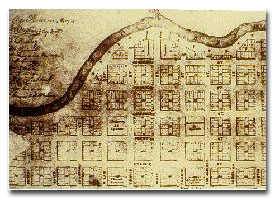OUR LEGACY - The Allen Brothers and Their Dream Town
 Augustus Allen and his brother John arrived in Galveston from New York in late 1831. Settling in San Augustine in 1832 and later in Nacogdoches, they engaged in a variety of promotional enterprises before arriving in the Harrisburg area.
Augustus Allen and his brother John arrived in Galveston from New York in late 1831. Settling in San Augustine in 1832 and later in Nacogdoches, they engaged in a variety of promotional enterprises before arriving in the Harrisburg area.
Being shrewd businessmen, it did not take Augustus and John Allen long to realize the commercial potential of the area surrounding Buffalo Bayou. They were initially interested in several unavailable tracts of land, which included Harrisburg, for the founding of a town. But the Harris estate was under litigation. Later after further investigation, the Allen's learned that the bayou was navigable to a point further upstream and decided that the confluence of White Oak Bayous would make a good sport for a settlement.
In the summer of 1836, shortly after the Battle of San Jacinto, the Allen's offered Mrs. Elizabeth Parrott $5,000 for a half a league of the John Austin stake along Buffalo Bayou. The widow of John Austin, who was one of the "Old Three Hundred" colonists accompanying Stephen F. Austin, Mrs. Parrott readily accepted. Thus, on August 30, 1836, the Allen's purchased some 6,000 acres of land on the southern bank of the tree-lined, murky Buffalo Bayou, naming the site "Houston, in honor of the man who had become the hero of the new republic.
Gambling on the success for their new land venture, Augustus and John Allen believed that General Sam Houston, hero of the Battle of San Jacinto, was assured of election as first president of Texas. On August 30, 1836, the Allen's announced the opening of their town site, offering land for sale at one dollar per acre. Extolling Houston as the future "great interior commercial emporium of Texas," they advertised its merits, both real and anticipated, in the newspapers of Louisville, New Orleans, Washington, and New York. Among the "exaggerated" descriptions was that of Houston as a thriving port city, propitiously located on Buffalo Bayou and "by nature" destined to be the republic's "future seat of government."
As expected, Texans elected Sam Houston their first president. Augustus Allen was elected to serve as the representative of Nacogdoches in the republic's first congress, which convened in October at Columbia, south of Houston. Offering his new "town" as the capital, Allen bolstered his proposal with promises of constructing a capitol building and providing land for government offices. His offer won congressional acceptance in the final resolution prior to adjournment in December. Houston, consisting of a few rough shelters and tents, became the new nation's capital.
In November 1836, Gail and Thomas Borden surveyed and mapped the original town site, from Buffalo Bayou on the north to what is now Texas Avenue on the south, and from Crawford on the east to Bagby on the west. Gail Borden, who later achieved fame as the inventor of the process for condensing milk, was publisher of the Telegraph and Texas Register, the newspaper he founded in San Felipe in 1835 and moved to Houston in 1837. The Borden's plotted Texas Avenue, the western boundary of the Allen's town site, 14 steers or 100 feet wide, in order to accommodate cattle drives. The Allen brothers, in turn, named many of the settlement's first broad streets (most were 80 feet wide) after early Texas settlers and heroes; several of those who fought in the Battle of San Jacinto chose to live in Houston City, as it was called.
Faced with the enormous task of building a capital city from scratch, the Allen brothers began three major building projects; the capitol, the county courthouse, and a long row of buildings divided into stores and stalls. The block designated by the Allen's for the county courthouse is today, as in the past, occupied by that institution.
To convince skeptics that Buffalo Bayou was navigable, the Allen's offered the captain of the steamship Laura M. $1,000 to carry supplies and settlers from Galveston to Houston. Passing a few tents and rough shelters without realizing that that was the "prosperous" city of Houston, the captain continued on for about three more miles, until he was no longer able to navigate the vine-choked bayou and had to back his steamer down to "Allen's Landing" at the foot of Main and Congress streets. Although the last 16 miles of the journey from Harrisburg had taken three days, the captain completed the voyage, earning his incentive.
When the new republic's congress arrived in Houston in 1837, the capital was still incomplete, and only a few buildings had been erected. John James Audubon, the prominent naturalist, visited Houston at that time, studying and painting birds and other wildlife along the Gulf Coast. In a meeting with Sam Houston, Audubon expressed displeasure concerning the mud and the incomplete condition of the buildings. Thence, until the city paved its streets in the 1890's, Houstonians were called "mud turtles"—the latter part of the epithet surely being a misnomer if one considers the hectic pace of growth even in those early days.






